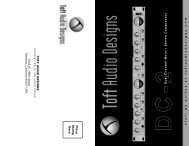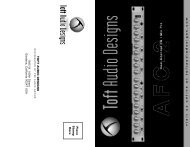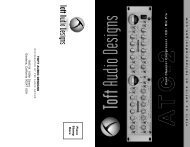You also want an ePaper? Increase the reach of your titles
YUMPU automatically turns print PDFs into web optimized ePapers that Google loves.
www.toftaudio.com19the line amplification is 0dB. Decreasing the level will attenuate the signal by up to -15dB and increasingit from midway will amplify it by up to 25dB.Once the recording has been made, it can be played back either via the Submaster section or Monitorsections of the input channels. This is explained in detail in the previous ‘Multi-Track Recording’section.Mixing DownChanging from the recording mode to mixing on the Series ATB is very easy to accomplish as a lot ofthe functions are selectable by push buttons rather than re-plugging connections.If the replay lines from the multi-track recorder have been connected to the ‘LINE’ jacks on eachInput module, depressing the ‘LINE’ button at the top of the module will bring the signal through thechannel fader. If the replay lines from the multi-track recorder have been connected to the ‘MON’jack on the rear of the input module (as would be the case when using the channel monitor sectionfor multi-track monitoring), depressing the ‘I/P REV’ button will bring those signals through the inputchannel via the line input. Any signal that was connected to the line input will now be routed throughthe channel monitor section.The input level control at the top of the module should be at it’s midway position and the channelfader advanced until the green -20db illuminates and an appropriate signal level is metered on themaster left/right bargraph displays.To select a channel to mix it is only necessary to depress the ‘L-R’ button on the appropriate channellocated next to the channel fader. The channel pan control will position the signal in the stereo image.The channel fader will control the level to the stereo mix which will be metered on both the leftand right bargraph displays located in the master section as well as the two analogue meters. Thestereo master fader located in the Master Module should be put to the top of it’s travel and the mastermonitor level control should be adjusted so that the signal from the control room monitor speakersis at the appropriate level. When the final mix has been recorded on one of the two analogue 2track recorders, or digital recorder that can be connected to the console, replay of the final stereo mixcan be made via the ‘2 TK 1 RET ’, ‘2 TK 2 RET ’, or ‘2 TK DIG RET ’, selection buttons on the mastermodule.When building up the mix, it is important to work with the relationship between the input level controland the channel fader such that the fader is always as close to the top of it’s travel as possibleyet still allowing enough in hand to increase gain for solo passages etc. If the fader is operated toolow in it’s travel and the input level control too far advanced, overload/headroom problems are morelikely to occur especially when introducing equalisation.As described in the previous sections on recording and overdubbing, signal processing such as limiter/compressorscan be added to individual channels via the ‘INSERT.’ send and return jacks. Alternatively,overall limiting/compression of the stereo mix can be accomplished by means of the ‘MASTERINS.’ left and right jacks located behind the master module.





